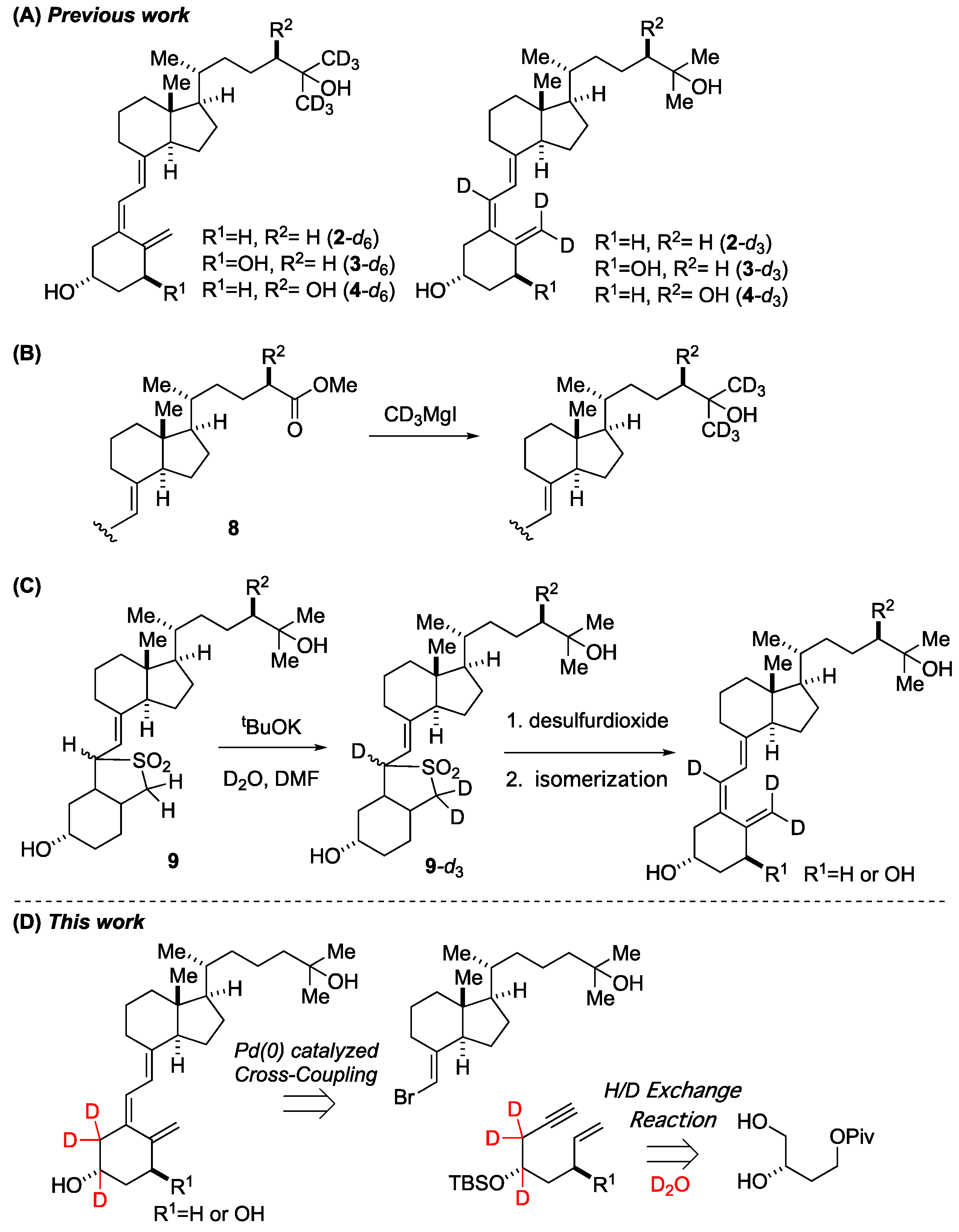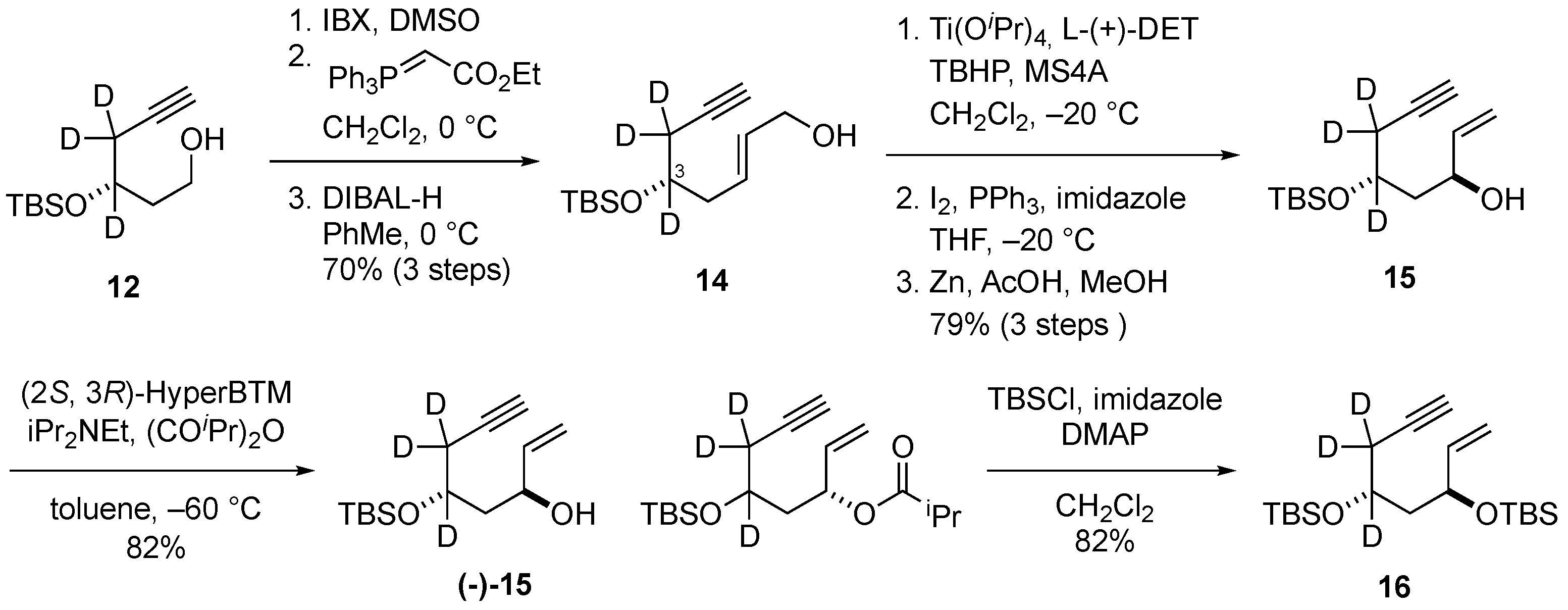Synthesis of Deuterium-Labeled Vitamin D Metabolites as Internal Standards for LC-MS Analysis
Abstract
:1. Introduction
2. Results
2.1. Derivatization of 2, 6, 7 for LC-MS/MS, and Preparation of Calibration Curves
2.2. Quantification of the D3 Derivatives in Human Serum
3. Conclusions
Supplementary Materials
Author Contributions
Funding
Acknowledgments
Conflicts of Interest
References and Notes
- Fleet, J.C. Regulation of intestinal calcium and phosphate absorption. In Vitamin D; Elsevier: Amsterdam, The Netherlands, 2018; pp. 329–342. [Google Scholar]
- David, V.; Quarles, L.D. FGF23/Klotho new regulators of vitamin D metabolism. In Vitamin D; Elsevier: Amsterdam, The Netherlands, 2011; pp. 747–761. [Google Scholar]
- Lips, P. Relative Value of 25(OH)D and 1,25(OH)2D measurements. J. Bone Miner. Res. 2007, 22, 1668–1671. [Google Scholar] [CrossRef] [PubMed]
- Holick, M.F. Vitamin D status: Measurement, interpretation, and clinical application. Ann. Epidemiol. 2009, 19, 73–78. [Google Scholar] [CrossRef] [PubMed] [Green Version]
- Janjetovic, Z.; Tuckey, R.C.; Nguyen, M.N.; Thorpe, E.M.; Slominski, A.T. 20,23-dihydroxyvitamin D3, novel P450scc product, stimulates differentiation and inhibits proliferation and NF-kB activity in human keratinocytes. J. Cell. Physiol. 2010, 223, 36–48. [Google Scholar] [PubMed] [Green Version]
- Janjetovic, Z.; Zmijewski, M.A.; Tuckey, R.C.; DeLeon, D.A.; Nguyen, M.N.; Pfeffer, L.M.; Slominski, A.T. 20-Hydroxycholecalciferol, product of vitamin D3 hydroxylation by P450scc, decreases NF-κB activity by increasing IκBα levels in human keratinocytes. PLoS ONE 2009, 4, e5988. [Google Scholar] [CrossRef] [Green Version]
- Wang, J.; Slominski, A.T.; Tuckey, R.C.; Janjetovic, Z.; Kulkarni, A.; Chen, J.; Postlethwaite, A.E.; Miller, D.; Li, W. 20-Hydroxyvitamin D3 inhibits proliferation of cancer cells with high efficacy while being non-toxic. Anticancer Res. 2012, 32, 739–746. [Google Scholar]
- Li, W.; Chen, J.; Janjetovic, Z.; Kim, T.K.; Sweatman, T.; Lu, Y.; Zjawiony, J.; Tuckey, R.C.; Miller, D.; Slominski, A.T. Chemical synthesis of 20S-hydroxyvitamin D3, which shows antiproliferative activity. Steroids 2010, 75, 926–935. [Google Scholar] [CrossRef]
- Slominski, A.T.; Janjetovic, Z.; Fuller, B.E.; Zmijewski, M.A.; Tuckey, R.C.; Nguyen, M.N.; Sweatman, T.; Li, W.; Zjawiony, J.; Miller, D.; et al. Products of vitamin D3 or 7-dehydrocholesterol metabolism by cytochrome P450scc show anti-leukemia effects, having low or absent calcemic activity. PLoS ONE 2010, 5, e9907. [Google Scholar] [CrossRef]
- Verma, A.; Cohen, D.J.; Schwartz, N.; Muktipaty, C.; Koblinski, J.E.; Boyan, B.D.; Schwartz, Z. 24R,25-Dihydroxyvitamin D3 regulates breast cancer cells in vitro and in vivo. Biochim. Biophys. Acta BBA—Gen. Subj. 2019, 1863, 1498–1512. [Google Scholar] [CrossRef]
- Verma, A.; Cohen, D.J.; Jacobs, T.W.; Boyan, B.D.; Schwartz, Z. The relative expression of ERα Isoforms ERα66 and ERα36 controls the cellular response to 24R,25-Dihydroxyvitamin D3 in breast cancer. Mol. Cancer Res. 2021, 19, 99–111. [Google Scholar] [CrossRef]
- Kiyoki, M.; Kurihara, N.; Ishizuka, S.; Ishii, S.; Hakea, Y.; Kumegawa, M.; Norman, A.W. The unique action for bone metabolism of 1α,25-(OH)2D3-26,23-lactone. Biochem. Biophys. Res. Commun. 1985, 127, 693–698. [Google Scholar] [CrossRef]
- Ishizuka, S.; Miura, D.; Eguchi, H.; Ozono, K.; Chokki, M.; Kamimura, T.; Norman, A.W. Antagonistic action of novel 1α,25-Dihydroxyvitamin D3-26,23-lactone analogs on 25-hydroxyvitamin-D3-24-hydroxylase gene expression Induced by 1α,25-dihydroxy-vitamin D3 in human promyelocytic leukemia (HL-60) cells. Arch. Biochem. Biophys. 2000, 380, 92–102. [Google Scholar] [CrossRef] [PubMed]
- Ishizuka, S.; Norman, A.W. The differenece of biological activity amang four diastereoisomers of 1α,25dihydoroxycholecalciferol-26,23-lactone. J. Steroid Biochem. 1986, 25, 505–510. [Google Scholar] [PubMed]
- Mendoza, A.; Takemoto, Y.; Cruzado, K.T.; Masoud, S.S.; Nagata, A.; Tantipanjaporn, A.; Okuda, S.; Kawagoe, F.; Sakamoto, R.; Odagi, M.; et al. Controlled lipid β-oxidation and carnitine biosynthesis by a vitamin D metabolite. Cell Chem. Biol. 2021. [Google Scholar] [CrossRef] [PubMed]
- Shah, I.; Akhtar, M.K.; Hisaindee, S.; Rauf, M.A.; Sadig, M.; Ashraf, S.S. Clinical diagnostic tools for vitamin D assessment. J. Steroid Biochem. Mol. Biol. 2018, 180, 105–117. [Google Scholar] [CrossRef]
- It is difficult to develop an antibody that specifically recognizes the structure of the side chain of vitamin D metabolites, see; Kobayashi, N.; Higashi, T.; Saito, K.; Nlurayama, T.; Douya, R.; Shimada, K. Specificity of polyclonal antibodies raised against a novel 24,25-dihydroxyvitamin D3- bovine serum albumin conjugant linked through the C-11α or C-3 position. J. Steroid Biochem. Mol. Biol. 1997, 62, 79–87. [Google Scholar]
- Müller, M.J.; Volmer, D.A. Mass spectrometric profiling of vitamin D metabolites beyond 25-hydroxyvitamin D. Clin. Chem. 2015, 61, 1033–1048. [Google Scholar] [CrossRef] [Green Version]
- Higashi, T.; Shimada, K. Application of Cookson-type reagents for biomedical HPLC and LC/MS analyses: A brief overview: Cookson-type reagents for biomedical HPLC and LC/MS analyses. Biomed. Chromatogr. 2017, 31, e3808. [Google Scholar] [CrossRef] [Green Version]
- Seki, M.; Sato, M.; Takiwaki, M.; Takahashi, K.; Kikutani, Y.; Satoh, M.; Nomura, F.; Kuroda, Y.; Fukuzawa, S. A novel caged Cookson-type reagent toward a practical vitamin D derivatization method for mass spectrometric analyses. Rapid Commun. Mass Spectrom. 2020, 34, e8648. [Google Scholar] [CrossRef]
- Nicoletti, D.; Mouriño, A.; Torneiro, M.S. Synthesis of 25-hydroxyvitamin D3 and 26,26,26,27,27,27-hexadeutero-25-hydroxyvitamin D3 on solid support. J. Org. Chem. 2009, 74, 4782–4786. [Google Scholar] [CrossRef]
- Perlman, K.; Schnoes, H.K.; Tanaka, Y.; DeLuca, H.F.; Kabayashi, Y.; Taguchi, T. Chemical synthesis of (24R)-24,25-dihydroxy[26,27-3H]vitamin D3 of high specific activity. Biochemistry 1984, 23, 5041–5048. [Google Scholar] [CrossRef]
- Ray, R.; Vicchio, D.; Yergey, A.; Holick, M.F. Synthesis of 25-hydroxy-[6,19,19′-2H3vitamin D3 and 1α,25-dihydroxy-[6,19′-2H3]vitamin D3. Steroids 1992, 57, 142–146. [Google Scholar] [CrossRef]
- Yamada, S.; Shimizu, M.; Fukushima, K.; Niimura, K.; Maeda, Y. Syntheses of 24R,25-dihydroxy-[6,19,19-3H]vitamin D3 and 24R,25-dihydroxy-[6,19,19-2H]vitamin D3. Steroids 1989, 54, 145–157. [Google Scholar] [CrossRef]
- Yamada, S.; Suzuki, T.; Takayama, H. Novel regioselective C-6 and C-19 alkylation of vitamin D3 via its sulfur-dioxide adducts. Tetrahedron Lett. 1981, 22, 3085–3088. [Google Scholar] [CrossRef]
- Zhu, G.D.; Okamura, W.H. Synthesis of vitamin D (Calciferol). Chem. Rev. 1995, 95, 1877–1952. [Google Scholar] [CrossRef]
- Gu, J.; Rodriguez, K.; Kanda, Y.; Yang, S.; Ociepa, M.; Wilke, H.; Abrishami, A.; Joergensen, L.; Skak-Nielsen, T.; Chen, J.; et al. Convergent total synthesis of (+)-Calcipotriol: A scalable, modular approach to vitamin D analogs. ChemRxiv 2021. [Google Scholar] [CrossRef]
- Maegawa, T.; Fujiwara, Y.; Inagaki, Y.; Monguchi, Y.; Sajiki, H. A convenient and effective method for the regioselective deuteration of alcohols. Adv. Synth. Catal. 2008, 350, 2215–2218. [Google Scholar] [CrossRef]
- Pattenden, G.; González, M.A.; Little, P.B.; Millan, D.S.; Plowright, A.T.; Tornos, J.A.; Ye, T. Total synthesis of (±)-phorboxazole A, a potent cytostatic agent from the sponge Phorbas sp. Org. Biomol. Chem. 2003, 1, 4173–4208. [Google Scholar] [CrossRef]
- The enantiomers at C3 were separated after coupling the CD rings by HPLC purification.
- Akagi, Y.; Usuda, K.; Tanami, T.; Yasui, K.; Asano, L.; Uesugi, M.; Nagasawa, K. Synthesis of 1α- and 1β-amino-25-hydroxyvitamin D3. Asian J. Org. Chem. 2016, 5, 1247–1252. [Google Scholar] [CrossRef]
- Venkanna, A.; Sreedhar, E.; Siva, B.; Babu, K.S.; Prasad, K.R.; Rao, J.M. Studies directed towards the total synthesis of koshikalide: Stereoselective synthesis of the macrocyclic core. Tetrahedron Asymmetry 2013, 24, 1010–1022. [Google Scholar] [CrossRef]
- Gao, Y.; Klunder, J.M.; Hanson, R.M.; Masamune, H.; Ko, S.Y.; Sharpless, K.B. Catalytic asymmetric epoxidation and kinetic resolution: Modified procedures including in situ derivatization. J. Am. Chem. Soc. 1987, 109, 5765–5780. [Google Scholar] [CrossRef]
- Joannesse, C.; Johnston, C.P.; Concellón, C.; Simal, C.; Philp, D.; Smith, A.D. Isothiourea-catalyzed enantioselective carboxy group transfer. Angew. Chem. Int. Ed. 2009, 48, 8914–8918. [Google Scholar] [CrossRef] [PubMed]
- Trost, B.M.; Dumas, J.; Villa, M. New strategies for the synthesis of vitamin D metabolites via palladium-catalyzed reactions. J. Am. Chem. Soc. 1992, 114, 9836–9845. [Google Scholar] [CrossRef]
- Nagata, A.; Akagi, Y.; Masoud, S.S.; Yamanaka, M.; Kittaka, A.; Uesugi, M.; Odagi, M.; Nagasawa, K. Stereoselective synthesis of four calcitriol lactone diastereomers at C23 and C25. J. Org. Chem. 2019, 84, 7630–7641. [Google Scholar] [CrossRef] [PubMed]
- Kaufmann, M.; Schlingmann, K.; Berezin, L.; Molin, A.; Sheftel, J.; Vig, M.; Gallagher, J.C.; Nagata, A.; Masoud, S.S.; Sakamoto, R.; et al. Differential diagnosis of vitamin D–related hypercalcemia using serum vitamin D metabolite profiling. J. Bone Miner. Res. 2021, 36, 1340–1350. [Google Scholar] [CrossRef]








| Compound | SRM Transition (m/z) | Cone Voltage (kv) | CE (eV) |
|---|---|---|---|
| 25(OH)D3-DAP (2-DAP) | 619.4 > 341.2 [M + H]+ [A]+ | 48 | 28 |
| 25(OH)D3-23,26-lactone-DAP (6-DAP) | 647.4 > 341.2 | 48 | 28 |
| 1,25(OH)2D3-23,26-lactone-DAP (7-DAP) | 663.4 > 357.2 | 48 | 28 |
| 25(OH)D3-d3-DAP (2-d3-DAP) | 622.4 > 344.2 | 48 | 28 |
| 25(OH)D3-23,26-lactone-d3-DAP (6-d3-DAP) | 650.4 > 344.2 | 48 | 28 |
| 1,25(OH)2D3-23,26-lactone-d3-DAP (7-d3-DAP) | 666.4 > 360.2 | 48 | 28 |
Publisher’s Note: MDPI stays neutral with regard to jurisdictional claims in published maps and institutional affiliations. |
© 2022 by the authors. Licensee MDPI, Basel, Switzerland. This article is an open access article distributed under the terms and conditions of the Creative Commons Attribution (CC BY) license (https://creativecommons.org/licenses/by/4.0/).
Share and Cite
Nagata, A.; Iijima, K.; Sakamoto, R.; Mizumoto, Y.; Iwaki, M.; Takiwaki, M.; Kikutani, Y.; Fukuzawa, S.; Odagi, M.; Tera, M.; et al. Synthesis of Deuterium-Labeled Vitamin D Metabolites as Internal Standards for LC-MS Analysis. Molecules 2022, 27, 2427. https://doi.org/10.3390/molecules27082427
Nagata A, Iijima K, Sakamoto R, Mizumoto Y, Iwaki M, Takiwaki M, Kikutani Y, Fukuzawa S, Odagi M, Tera M, et al. Synthesis of Deuterium-Labeled Vitamin D Metabolites as Internal Standards for LC-MS Analysis. Molecules. 2022; 27(8):2427. https://doi.org/10.3390/molecules27082427
Chicago/Turabian StyleNagata, Akiko, Kazuto Iijima, Ryota Sakamoto, Yuka Mizumoto, Miho Iwaki, Masaki Takiwaki, Yoshikuni Kikutani, Seketsu Fukuzawa, Minami Odagi, Masayuki Tera, and et al. 2022. "Synthesis of Deuterium-Labeled Vitamin D Metabolites as Internal Standards for LC-MS Analysis" Molecules 27, no. 8: 2427. https://doi.org/10.3390/molecules27082427






